Nestled on the border of Nagaland and Manipur, Dzukou Valley is one of the most breathtaking trekking and camping destinations in India. Famous for its emerald grasslands, seasonal wildflowers, and the rare Dzukou Lily, this valley offers a slice of untouched beauty.
But before you pitch your tent, you must understand the camping permits and regulations that keep this fragile ecosystem safe. This guide explains why you need permits, how to get them, what they cost, and what rules you must follow to ensure a responsible and smooth camping experience.
Why Do You Need Camping Permits in Dzukou Valley?
Dzukou Valley lies in a protected area managed by the Southern Angami Youth Organization (SAYO). This local body ensures that tourism benefits the community and that trekkers respect the environment.
Permits help:
✅ Control the number of visitors and prevent overuse
✅ Fund the maintenance of trails and facilities
✅ Protect rare plants and wildlife
✅ Provide safety and emergency support to campers
Camping without a valid permit is strictly prohibited and can lead to fines or denial of entry.
Types of Permits Required for Dzukou Valley Camping
There are three types of permits or fees you must be aware of:
1️⃣ Entry Fee
2️⃣ Camping Fee
3️⃣ Inner Line Permit (ILP) – for Indian citizens from outside Nagaland
Let’s break down each in detail.
1. Entry Fee
This is a mandatory fee every visitor must pay, whether you are trekking for the day or staying overnight.
- Amount: ₹100–₹150 per person
- Where to Pay:
- At the entry checkpoint before you begin your trek (Viswema or Zakhama base).
- You’ll be given a receipt; keep it safe.
- Validity: Covers your stay in the valley for up to 3 days.
✅ Pro Tip: If you plan to stay longer, inform the checkpoint staff and pay any extra fees.
2. Camping Fee
If you are staying overnight in a tent, you must also pay a camping fee.
- Amount: ₹100–₹200 per tent per night (subject to seasonal revision)
- Where to Pay:
- At the same entry checkpoint, or directly at the Rest House once you arrive.
- Some trekkers prefer to pay at the Rest House so they can choose a spot first.
- What It Covers:
- Permission to camp in the designated zones near the Rest House.
- Use of basic toilet facilities and water sources.
✅ Tip: Carry exact cash as there is no card facility and mobile network is unreliable.
3. Inner Line Permit (ILP) – For Domestic Tourists
Indian citizens who are not residents of Nagaland must obtain an Inner Line Permit (ILP) to enter the state.
- Where to Get ILP:
- Documents Required:
- ID proof (Aadhaar, Passport, Voter ID).
- Passport-size photographs.
- Travel itinerary.
- Fees:
- ₹50–₹100 depending on where you apply.
- Validity:
- Typically 15 days, extendable.
✅ Important: Keep both your ILP and Dzukou entry permit with you at all times.
Do Foreigners Need Special Permits?
No Protected Area Permit (PAP) is required for foreigners since 2011. However:
- You must register with the Foreigner’s Registration Officer (FRO) in Kohima within 24 hours of arrival.
- Always carry your passport and visa photocopies.
How to Get Dzukou Valley Camping Permits – Step by Step
Step 1:
Obtain your Inner Line Permit (for domestic tourists).
Step 2:
Reach Viswema or Zakhama village checkpoint by taxi or local vehicle.
Step 3:
At the checkpoint:
- Fill out a visitor register.
- Show your ILP or ID.
- Pay the entry fee.
- Collect the receipt.
Step 4:
On reaching the Dzukou Valley Rest House:
- Decide if you’ll stay in the Rest House or camp.
- Pay the camping fee if you plan to pitch your own tent.
- Collect any available firewood or basic supplies.
Rules and Regulations for Camping in Dzukou Valley
To protect this fragile valley, strict rules apply:
✅ Camp only in designated zones near the Rest House.
✅ No bonfires outside the kitchen shed area.
✅ Carry out all trash. Plastic pollution is a big problem.
✅ No loud music or drones.
✅ Respect local customs and wildlife.
✅ Return to the checkpoint and sign out when you leave.
Violation of rules can lead to fines or being banned from the valley.
Important Tips for Smooth Camping Permit Process
🟢 Carry Extra Cash:
There are no ATMs or UPI payment options.
🟢 Start Early:
The checkpoints close by afternoon. If you arrive late, you might have to stay in the village and start next morning.
🟢 Verify Seasonal Changes:
Fees can vary during festivals (like Hornbill) or in peak summer bloom.
🟢 Save Receipts:
You might be asked to show them during random checks.
Frequently Asked Questions
1. Can I pre-book my camping permit online?
No, there is no online booking for camping permits. All payments are made in person.
2. Can I camp anywhere in the valley?
No, wild camping beyond the designated area is strictly prohibited.
3. Are permits refundable if I cancel my plan?
No refunds are issued once permits are paid.
4. Do I need any separate trekking permit?
The entry fee itself serves as your trekking permit.
Conclusion
Dzukou Valley camping permits are simple to get if you plan ahead. They help maintain this extraordinary landscape for future generations. By following the rules, carrying proper documents, and respecting local guidelines, you’ll enjoy a magical camping experience in one of India’s most beautiful valleys.
Prepare well, get your permits, and get ready to watch the misty sunrise over Dzukou’s rolling meadows—it will be a memory you’ll never forget.








